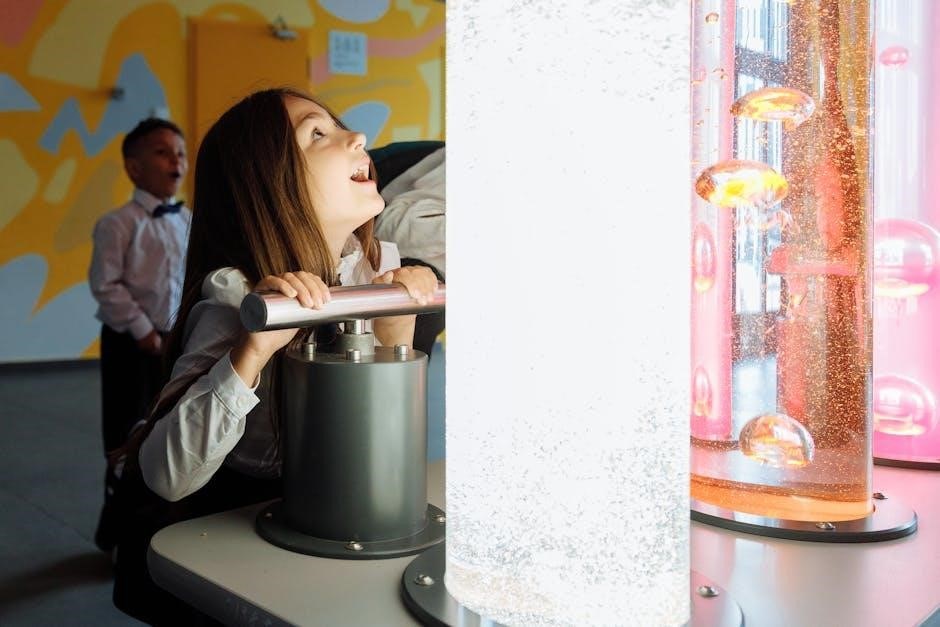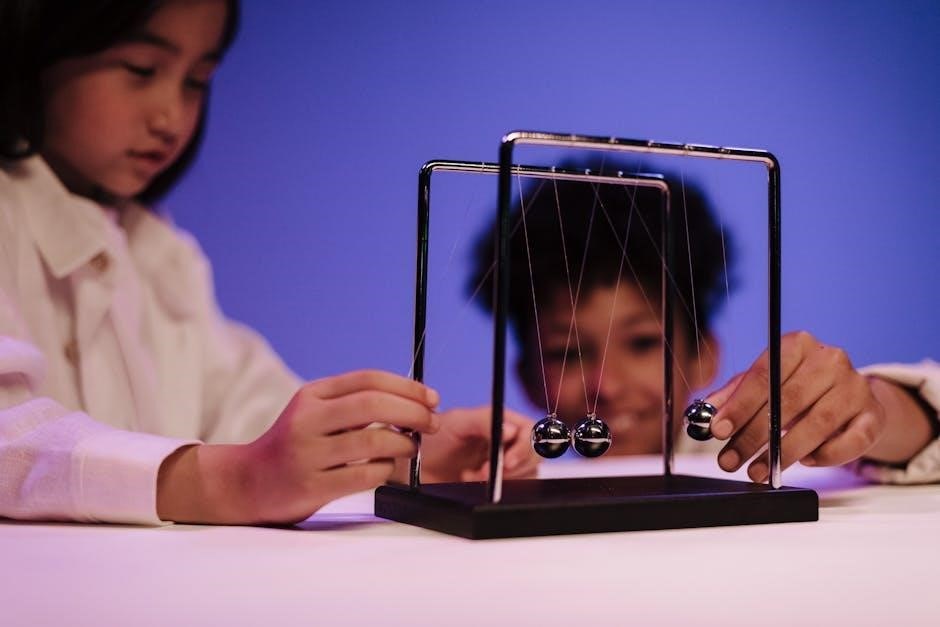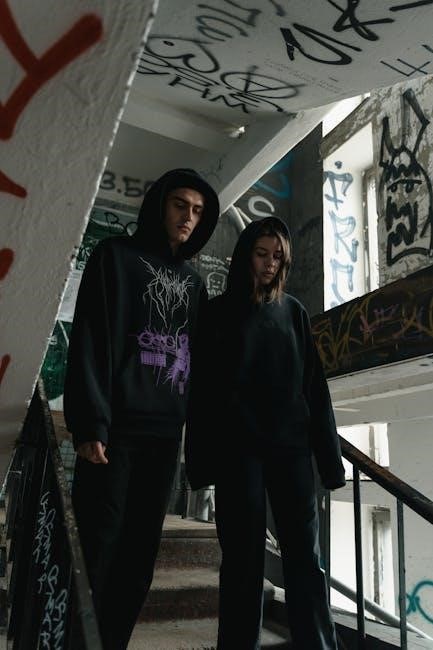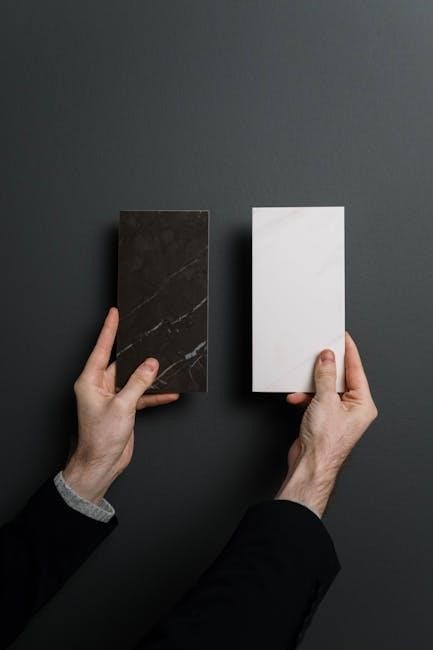Young’s Double Slit Experiment is a foundational demonstration of light’s wave-particle duality, showing interference patterns of bright and dark fringes when unobserved.
What is Young’s Double Slit Experiment?
Young’s Double Slit Experiment is a landmark study in physics that demonstrates the wave-particle duality of light. Conducted by Thomas Young in 1801, it involves passing light through two parallel slits, creating an interference pattern on a screen. This pattern, characterized by bright and dark fringes, confirms light’s wave-like behavior. However, when the slits are observed individually, light behaves as particles, highlighting its dual nature. The experiment’s simplicity yet profound implications make it a cornerstone of quantum mechanics, illustrating the wave function’s role in determining probabilities of particle detection. Its findings challenge classical interpretations of light and matter, sparking foundational debates in modern physics.

Historical Significance of the Experiment
Young’s Double Slit Experiment, conducted in 1801 by Thomas Young, revolutionized the understanding of light and its nature. It provided conclusive evidence for the wave theory of light, challenging Newton’s corpuscular view. The experiment’s interference pattern demonstrated light’s wave-like properties, laying the groundwork for quantum mechanics. Its findings influenced later scientists, including Einstein, in understanding light’s dual nature as both wave and particle. This experiment remains a cornerstone in physics education, illustrating wave-particle duality and the probabilistic nature of quantum phenomena. Its historical significance lies in bridging classical and modern physics, offering insights into the behavior of matter and energy that continue to shape scientific inquiry today.

Basic Setup of the Experiment
A light source shines through two parallel slits, creating an interference pattern on a screen. This simple yet elegant arrangement demonstrates wave-particle duality.
Apparatus Used in the Experiment
The experiment requires a coherent light source, such as a laser or monochromatic light, two parallel slits spaced closely together, and a screen to display the interference pattern. The light source illuminates the slits, creating a wave-like interference pattern on the screen. Additional components include a lens to focus the light, a slit system to ensure coherence, and a detector or observation screen. Modern setups may use advanced materials for slits and precise measurement tools. The simplicity of the apparatus belies its profound implications for understanding wave-particle duality. Proper alignment and calibration of the slits and light source are critical for observing the interference pattern clearly.
Procedure of the Double Slit Experiment
The experiment begins with setting up the apparatus, including aligning the light source, slits, and screen. The light source illuminates the slits, creating an interference pattern. Observers then record the pattern’s bright and dark fringes. Modern variations involve using lasers for coherence and advanced detectors. The procedure demonstrates wave-particle duality, showing light behaves as waves when unobserved and particles when measured. This step-by-step process reveals fundamental physics principles in action, making it a cornerstone of quantum mechanics studies. The experiment’s simplicity and profound results have made it a key demonstration in understanding light’s dual nature. Proper execution ensures clear interference patterns, essential for analyzing wave behavior. The procedure remains a vital tool in educating physicists and enthusiasts alike.
Expected Observations and Results
In the Double Slit Experiment, light passing through two parallel slits creates an interference pattern on a screen. This pattern consists of alternating bright and dark fringes, indicating constructive and destructive interference. The spacing between the fringes depends on the wavelength of the light and the distance between the slits. When observed, photons behave as particles, disrupting the interference pattern. This duality highlights the wave-particle nature of light. The experiment’s results confirm the principles of wave interference and quantum mechanics, providing insights into the fundamental behavior of light and matter. The observed pattern’s clarity demonstrates the coherence of the light source and the precision of the setup. These results have profound implications for understanding quantum phenomena. The experiment remains a cornerstone of physics education and research.

The Interference Phenomenon
The interference phenomenon in Young’s experiment reveals light’s wave nature, creating a pattern of bright and dark fringes due to constructive and destructive interference.
Understanding the Interference Pattern
Young’s Double Slit Experiment produces an interference pattern of bright and dark fringes on a screen, formed by constructive and destructive interference of light waves. The central fringe is the brightest and widest, with alternating dark and bright fringes of decreasing intensity. This pattern arises because light waves passing through the two slits either reinforce or cancel each other depending on their path difference. The spacing between fringes depends on the wavelength of light, the distance between the slits, and the screen’s distance from the slits. Mathematically, the fringe spacing is given by d sinθ = mλ, where d is the slit separation, θ is the angle from the central fringe, m is the fringe order, and λ is the wavelength. This phenomenon is a direct demonstration of wave-particle duality, confirming light’s wave nature while also hinting at its particle-like behavior when observed individually.
Bright and Dark Fringes in the Interference Pattern
The interference pattern in Young’s Double Slit Experiment consists of bright and dark fringes, resulting from constructive and destructive interference of light waves. Bright fringes occur where waves reinforce each other, while dark fringes appear where waves cancel out. The central bright fringe is the widest and most intense, with alternating narrower bright and dark fringes on either side. The spacing between fringes depends on the wavelength of light, the distance between the slits, and the screen’s distance from the slits. This pattern provides direct evidence of wave-particle duality, illustrating light’s wave-like behavior through interference while also hinting at its particle nature when observed individually. The fringes’ clarity and spacing are crucial for understanding light’s fundamental properties.
Role of Wavelength and Distance Between Slits
The wavelength of light and the distance between the slits play crucial roles in determining the interference pattern in Young’s Double Slit Experiment. The wavelength affects the spacing between bright and dark fringes, with shorter wavelengths producing narrower fringe patterns. Similarly, the distance between the slits influences the fringe separation, as wider slit spacing results in closer fringes. These factors are mathematically related through the formula for fringe width, demonstrating the inverse relationship between slit separation and fringe spacing. Understanding these relationships is essential for analyzing the wave-like behavior of light and its interference properties. The experiment highlights how wavelength and slit distance directly impact the observable interference pattern, providing insights into light’s dual nature.

Wave-Particle Duality
Young’s Double Slit Experiment demonstrates wave-particle duality, showing light’s dual behavior as both wave and particle, with the observer effect influencing the observed phenomenon.
Demonstration of the Wave Nature of Light
The Double Slit Experiment vividly demonstrates the wave nature of light by producing an interference pattern of bright and dark fringes on a screen. When light passes through two parallel slits, it creates a series of alternating bright and dark regions, characteristic of wave interference. This phenomenon occurs because the light waves from each slit interfere constructively and destructively with each other. The experiment challenges the classical particle theory of light, as particles would not produce such an interference pattern. Instead, the observed fringes are a clear indication of wave behavior. This fundamental demonstration laid the groundwork for understanding wave-particle duality, a cornerstone of quantum mechanics. The experiment remains a pivotal example of light’s wave-like properties when not observed as particles.
Evidence for the Particle Nature of Light
The Double Slit Experiment provides compelling evidence for the particle nature of light when observed directly. When light is monitored as it passes through the slits, it behaves like particles, creating two distinct patterns on the screen. This aligns with the quantum mechanics principle that observation alters behavior, as the interference pattern disappears. The particles, or photons, act like discrete entities when measured, supporting the particle theory of light. This duality is central to understanding light’s nature, as it exhibits both wave and particle properties under different conditions. The experiment’s findings have been instrumental in shaping quantum theory and continue to influence modern physics research.
Concept of Wave Function and Probability
The Double Slit Experiment introduces the concept of wave function and probability in quantum mechanics. The wave function describes the quantum state of light or particles, determining the likelihood of their position upon measurement. When unobserved, the wave function interferes, creating an interference pattern of bright and dark fringes. This pattern reflects the probabilistic nature of quantum systems, where the square of the wave function’s amplitude gives the probability density of finding a particle. The experiment highlights how particles behave as waves when unobserved, illustrating the fundamental randomness and statistical nature of quantum phenomena. This concept is central to understanding wave-particle duality and the probabilistic framework of quantum mechanics.

Quantum Mechanics and the Double Slit Experiment
Young’s Double Slit Experiment validates quantum mechanics by demonstrating wave-particle duality and interference patterns, explaining light’s probabilistic behavior through wave functions and interference principles.
Quantum Explanation of the Interference Pattern
The interference pattern in Young’s Double Slit Experiment is explained by quantum mechanics as a result of wave-particle duality. When light passes through the slits, it creates wave functions that interfere with each other constructively or destructively. The resulting pattern on the screen is a probability distribution of where photons are likely to land, governed by the principles of quantum superposition. The wave function determines the likelihood of finding a photon at a specific point, and the interference pattern emerges from the overlap of these probabilities. This quantum explanation also introduces the concept of the observer effect, where measuring which slit a photon passes through collapses the wave function, altering the interference pattern. Thus, the experiment provides a foundational demonstration of quantum principles in action.
Heisenberg Uncertainty Principle and Its Implications
The Heisenberg Uncertainty Principle states that it is impossible to simultaneously know the exact position and momentum of a particle. In Young’s Double Slit Experiment, this principle becomes evident when attempting to measure which slit a photon passes through. The act of measurement disturbs the photon’s momentum, thereby altering the interference pattern. This demonstrates how observing a quantum system inherently affects its behavior. The principle underscores the limitations of precision in quantum mechanics and highlights the fundamental nature of wave-particle duality. Its implications extend beyond the experiment, influencing our understanding of measurement and observation in quantum systems, and reinforcing the probabilistic nature of quantum phenomena.
The Observer Effect in Quantum Mechanics
The observer effect in quantum mechanics highlights how the act of observation fundamentally alters the behavior of particles. In Young’s Double Slit Experiment, attempting to measure which slit a photon passes through disrupts the interference pattern, illustrating this effect. The mere act of observation forces photons to behave as particles rather than waves, collapsing the wave function. This phenomenon demonstrates the intrinsic relationship between measurement and system behavior in quantum mechanics. It raises profound questions about the role of observation in shaping reality and the limits of measurement at the quantum level. The observer effect underscores the strange and counterintuitive nature of quantum phenomena.

Applications of Young’s Double Slit Experiment
- It laid the foundation for quantum mechanics and wave-particle duality concepts.
- It influenced particle physics, particularly in understanding electron behavior.
- It inspired technological advancements in optics and telecommunications.
Foundation for Quantum Mechanics
Young’s Double Slit Experiment provided the cornerstone for understanding wave-particle duality, a fundamental concept in quantum mechanics. By demonstrating the interference pattern of light, it challenged Newton’s corpuscular theory and supported Huygens’ wave theory. This experiment laid the groundwork for quantum principles like superposition and wave function probability amplitudes. The interference phenomenon observed in the experiment is a direct manifestation of wave behavior, which later influenced the development of quantum mechanics. The experiment’s results also inspired discussions about the nature of matter, leading to the realization that particles like electrons exhibit wave-like properties. This foundational work has shaped modern quantum theory and remains a key example in understanding quantum phenomena.
Implications in Particle Physics
Young’s Double Slit Experiment has profound implications in particle physics, extending beyond light to other particles. The wave-particle duality demonstrated by the experiment suggests that particles like electrons, neutrons, and even atoms exhibit wave-like behavior when unobserved. This understanding has led to the study of quantum phenomena such as quantum tunneling and entanglement. The experiment’s results align with the principles of quantum field theory, influencing the development of the Standard Model of particle physics. Furthermore, the interference pattern observed in the experiment supports the concept of wave functions in particle physics, enabling deeper insights into the behavior of fundamental particles and their interactions. These implications have shaped modern particle physics and continue to inspire research in quantum mechanics and beyond.
Technological Applications and Innovations
Young’s Double Slit Experiment has inspired numerous technological advancements, particularly in optics and quantum mechanics. The interference patterns observed in the experiment form the basis for technologies like holography, which relies on wave interference to create 3D images. Additionally, the experiment’s principles are used in quantum computing, where wave-particle duality is harnessed to develop quantum bits (qubits). The experiment also influences the development of quantum cryptography, which leverages light’s wave-like properties for secure communication. Furthermore, the understanding of wave interference has led to innovations in fiber optics and photonics, enhancing data transmission and light manipulation. These technological applications highlight the experiment’s enduring impact on modern science and engineering.

Modern Variations and Extensions
Modern adaptations of Young’s experiment use particles like electrons and photons, demonstrating wave-particle duality. Advances in technology enable precise measurements and observations.
Double Slit Experiments with Different Particles
Young’s double slit experiment has been extended to particles beyond light, such as electrons, neutrons, and even atoms or molecules. These experiments demonstrate the wave-particle duality of matter. Electrons, when passed through slits, create interference patterns similar to light, showing their wave-like behavior. Neutrons and atoms also exhibit such patterns, reinforcing quantum mechanics principles. Interestingly, even large molecules, like buckyballs, display interference, challenging classical notions of particles. These variations highlight the universality of quantum behavior and provide insights into the nature of matter at microscopic scales. They also raise questions about the limits of wave-particle duality and its implications for modern physics research.
Technological Advancements in the Experiment
Modern advancements have significantly enhanced Young’s double slit experiment, improving precision and accessibility. Laser light sources now provide coherent and monochromatic illumination, producing sharper interference patterns. Digital detectors and sensors enable real-time data acquisition and analysis, replacing traditional screens. High-resolution imaging systems capture fringe patterns with unprecedented clarity. Nanotechnology allows for the fabrication of slits with precise dimensions, optimizing the setup. Computational tools simulate the experiment, aiding educational and research purposes. Automation ensures consistent experimental conditions, such as maintaining stable slit separation and light intensity. These innovations have made the experiment more accurate, easier to perform, and adaptable for diverse applications, from education to cutting-edge research in quantum mechanics.
Implications for Modern Physics Research
Young’s double slit experiment has profound implications for modern physics research, particularly in understanding quantum mechanics. The experiment’s demonstration of wave-particle duality remains a cornerstone in studying quantum behavior, influencing theories like quantum field theory and particle physics. Modern research extends the experiment to particles beyond light, such as electrons and atoms, deepening insights into quantum phenomena. The principles observed in interference patterns inform the development of quantum computing and nanotechnology. Additionally, the experiment’s findings contribute to understanding quantum entanglement and superposition, shaping contemporary research in theoretical and applied physics. Its simplicity and profound results make it a foundational tool for exploring the quantum world.
Key Figures and Contributions
Thomas Young pioneered the double slit experiment, demonstrating light’s wave nature. Other key figures like Augustin-Jean Fresnel and Joseph von Fraunhofer advanced wave theory and optical principles.
Thomas Young and His Contributions
Thomas Young is renowned for his groundbreaking double slit experiment in 1801, which conclusively demonstrated the wave nature of light. His innovative approach challenged the prevailing corpuscular theory of light proposed by Newton. Young’s experiment showed interference patterns, proving that light behaves as a wave. This discovery laid the foundation for modern wave optics and quantum mechanics. Additionally, Young made significant contributions to various fields, including optics, acoustics, and Egyptology. His work on the interference of light waves introduced the concept of wave-particle duality, a cornerstone of quantum theory. Young’s contributions remain pivotal in understanding the behavior of light and matter, influencing countless scientific advancements. His legacy endures as a pioneer in the study of wave phenomena.
Other Scientists Who Contributed to the Experiment
Beyond Thomas Young, several scientists have contributed to refining and interpreting the double slit experiment. Augustin-Jean Fresnel further developed wave theory, supporting Young’s findings. Louis de Broglie extended the concept to matter, proposing particles like electrons exhibit wave-like behavior. Dennis Gabor’s work on holography built on wave interference principles. Richard Feynman popularized the experiment in his lectures, emphasizing its importance in quantum mechanics. Modern physicists have expanded the experiment to particles like neutrons and molecules, demonstrating universal wave behavior. These contributions have deepened understanding of wave-particle duality and its quantum implications, shaping modern physics. Their work highlights the experiment’s enduring relevance in exploring fundamental physics questions.

Publications and Resources
Key resources include Thomas Young’s original paper, educational tutorials explaining wave interference, and recent research articles exploring modern applications of the double slit experiment.

Original Paper by Thomas Young
Thomas Young’s groundbreaking paper, titled Experiments and Calculations Relative to Physical Optics, was published in 1803. In it, he detailed his iconic double-slit experiment, demonstrating light’s wave nature through interference patterns. Young’s work challenged the prevailing particle theory of light, proposing instead that light exhibits wave-like properties. His experiments included precise measurements of light interference, leading to the calculation of the wavelength of light. The paper also introduced the concept of coherence and the mathematical framework for understanding wave interference. This seminal work laid the foundation for modern wave optics and quantum mechanics. Today, the paper remains a cornerstone of physics, accessible in historical archives and modern compilations, inspiring ongoing research in light and matter wave behavior.
Educational Resources and Tutorials
Several educational resources and tutorials are available to help students and educators understand Young’s double-slit experiment. Textbooks on physics often include detailed explanations and diagrams of the experiment. Online platforms like Khan Academy, Coursera, and edX offer video lectures and interactive simulations. Universities and educational websites provide downloadable PDF guides, such as “Young’s Double Slit Experiment Explained,” which simplify complex concepts. Additionally, many YouTube channels dedicate videos to explaining the experiment, often with animations and real-world applications. These resources cater to different learning styles, making the experiment accessible to a wide audience, from high school students to advanced researchers.
Recent Studies and Research Papers
Recent studies on Young’s double-slit experiment have explored its implications in quantum mechanics and modern physics. Researchers have published papers examining the experiment’s relevance to wave-particle duality, quantum superposition, and the role of observation in quantum systems. Advances in technology have enabled variations of the experiment using particles like electrons, neutrons, and even larger molecules. These studies, often detailed in journals like Nature and Physical Review Letters, provide deeper insights into quantum behavior. Additionally, theoretical papers have proposed new interpretations of the interference pattern, linking it to quantum information theory and foundational questions in physics. These works highlight the experiment’s enduring significance in advancing our understanding of the quantum world.
Young’s double-slit experiment remains a cornerstone of physics, demonstrating the wave-particle duality of light and laying the foundation for quantum mechanics. Its simplicity belies its profound implications, revealing how waves interfere and particles behave probabilistically. The experiment has been extended to various particles, challenging classical understanding and sparking debates about reality and observation. Modern research continues to explore its quantum mysteries, such as the observer effect and superposition. This experiment not only shaped our understanding of light but also inspired technologies like quantum computing and optics. Its enduring relevance ensures it will remain a vital tool in exploring the quantum world, offering insights into the nature of reality itself.




Be the first to reply